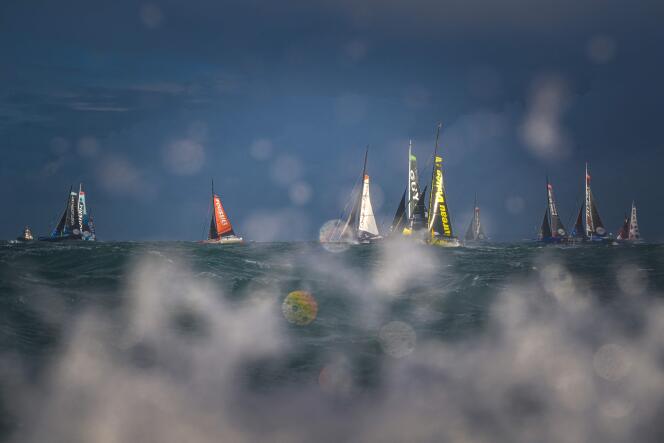A ballet of sleepy shadows busy freeing the boats from their fenders by the light of headlamps. Duos of sailors focused on the weather and impatient to do battle, after 10 days stuck at the dock due to the violence of storms Ciaran and Domingos. A few farewell signs and rare applause resounding in the early hours of the morning, in the icy wind and the Le Havre night, and no live television…
The festive atmosphere and popular fervor which usually accompany the departures of transatlantic races was notably absent when the forty Imocas – the largest fleet of 18 meter monohulls ever entered in an offshore race – left the Paul-Basin in single file. Vatine, from four in the morning, Tuesday November 7, for the 16e edition of the Transat Jacques Vabre linking Le Havre (Seine-Maritime) to Fort-de-France (Martinique).
“It should have been a big start for my first big race [en Imoca] and in the end it’s done almost behind closed doors, at night; it’s weird and not ideal for sponsors, but much less stressful than with the family and the world who were all there at the false start [le 29 octobre] and who did not return”, confided Violette Dorange, Worldabout to cast off its hawsers.
At only 22 years old, but already with a solid career in Mini (6.50 meter monohull) and Figaro (10 meter monohull), the youngest of the fleet is launching on this transatlantic race. Become, with a view to the Vendée Globe 2024, alongside the experienced Damien Guillou, 40 years old, more familiar with these unusual conditions. “I had a similar start in Imoca during Covid; we left our respective home ports to find ourselves directly on a starting line in Les Sables d’Olonne, so we found ourselves on the water,” he remembered, Tuesday morning, not angry either at having “fewer parameters to manage”while a frontal passage with strong winds will pick up the fleet as soon as it leaves the Pointe de Bretagne.
The four classes of boats now on the way
Launched in a wind of 20 knots to 25 knots and disorderly seas, the start of this Atlantic ride of 3,750 miles (a little over 6,000 kilometers), with the only obligatory intermediate course mark, Santa Maria Island – the southernmost of the Azores archipelago to be left to starboard – did not spoil everyone.
For not having respected the departure procedure, Medallia British Pip Hare and Nick Bubb as Valley Office led by Louis Burton and Davy Beaudart received, from the outset, a five-hour penalty. This handicap could weigh heavily on arrival in Martinique, which the organizers estimate around November 17, while some routings indicate it rather between November 19 and 21.
You have 45% of this article left to read. The rest is reserved for subscribers.
